Below you will find a list of references used in this fact sheet. All sources used may be accessed via our library portal, where more literature on this subject may also be found.
Relevant reviews about young drivers:
International handbook on young drivers: [65]. Fisher, D.L., Caird, J.K., Horrey, W.J. & Trick, L.M. (2017). Handbook of teen and novice drivers: research, practice, policy, and directions. CRC Press, Boca Raton.
Dutch review of the state of knowledge about young drivers, dating from 2005: Vlakveld, W.P. (2005). Jonge beginnende automobilisten, hun ongevalsrisico en maatregelen om dit terug te dringen [Young, novice motorists, their crash rates, and measures to reduce them. A literature study]. R-2005-3 [Summary in English]. SWOV, Leidschendam
Sources:
[1]. Cassarino, M. & Murphy, G. (2018). Reducing young drivers’ crash risk: Are we there yet? An ecological systems-based review of the last decade of research. In: Transportation Research Part F: Traffic Psychology and Behaviour, vol. 56, p. 54-73.
[2]. Vlakveld, W.P. (2005). Jonge beginnende automobilisten, hun ongevalsrisico en maatregelen om dit terug te dringen [Young, novice motorists, their crash rates, and measures to reduce them. A literature study]. R-2005-3 [Summary in English]. SWOV, Leidschendam.
[3]. Curry, A.E., Metzger, K.B., Williams, A.F. & Tefft, B.C. (2017). Comparison of older and younger novice driver crash rates: Informing the need for extended Graduated Driver Licensing restrictions. In: Accident Analysis & Prevention, vol. 108, p. 66-73.
[4]. Gicquel, L., Ordonneau, P., Blot, E., Toillon, C., et al. (2017). Description of various factors contributing to traffic accidents in youth and measures proposed to alleviate recurrence. In: Frontiers in Psychiatry, vol. 8, nr. 94.
[5]. Gogtay, N., Giedd, J.N., Lusk, L., Hayashi, K.M., et al. (2004). Dynamic mapping of human cortical development during childhood through early adulthood. In: Proceedings of the National Academy of Sciences of the United States of America, PNAS, vol. 101, nr. 21, p. 8174-8179.
[6]. Steinberg, L. (2008). A social neuroscience perspective on adolescent risk-taking. In: Developmental review DR, vol. 28, nr. 1, p. 78-106.
[7]. Walshe, E.A., Winston, F.K., Betancourt, L.M., Khurana, A., et al. (2019). Working memory development and motor vehicle crashes in young drivers. In: JAMA network open, vol. 2, nr. 9, p. e1911421.
[8]. Vlakveld, W.P. (2011). Hazard anticipation of young novice drivers: assessing and enhancing the capabilities of young novice drivers to anticipate latent hazards in road and traffic situations. Dissertation Rijksuniversiteit Groningen. SWOV-dissertation series. SWOV, Leidschendam.
[9]. Craen, S. de (2010). The X-factor. A longitudinal study of calibration in young novice drivers. Dissertation Rijksuniversiteit Groningen. SWOV-dissertation series. SWOV, Leidschendam.
[10]. Cordellieri, P., Baralla, F., Ferlazzo, F., Sgalla, R., et al. (2016). Gender effects in young road users on road safety attitudes, behaviors and risk perception. In: Frontiers in Psychology, vol. 7, nr. 1412.
[11]. Vissers, J., Dekker, G.M. & Rijniers, R. (2019). Diepteonderzoek beginnende bestuurders. Royal Haskoning DHV, Amersfoort.
[12]. McDonald, C.C., Sommers, M.S. & Winston, F.K. (2017). Novice teen driver crash patterns. In: Fisher, D.L., et al. (red.), Handbook of teen and novice drivers: research, practice, policy, and directions. CRC Press, Boca Raton.
[13]. Møller, M. & Sigurðardóttir, S.B. (2009). The relationship between leisure time and driving style in two groups of male drivers. In: Transportation Research Part F: Traffic Psychology and Behaviour, vol. 12, nr. 6, p. 462-469.
[14]. Geber, S., Baumann, E., Czerwinski, F. & Klimmt, C. (2019). The efects of social norms among peer groups on risk behavior: A multilevel approach to differentiate perceived and collective norms. In: Communication Research.
[15]. Guggenheim, N., Taubman – Ben-Ari, O. & Ben-Artzi, E. (2020). The contribution of driving with friends to young drivers’ intention to take risks: An expansion of the theory of planned behavior. In: Accident Analysis & Prevention, vol. 139, p. 105489.
[16]. Ouimet, M.C., Pradhan, A.K., Brooks-Russell, A., Ehsani, J.P., et al. (2015). Young drivers and their passengers: A systematic review of epidemiological studies on crash risk. In: Journal of Adolescent Health, vol. 57, nr. 1, p. s24-S35.e26.
[17]. Klauer, S.G., Guo, F., Simons-Morton, B.G., Ouimet, M.C., et al. (2014). Distracted driving and risk of road crashes among novice and experienced drivers. In: New England Journal of Medicine, vol. 370, nr. 1, p. 54-59.
[18]. European Commission (2018). Fatigue. European Commission, Directorate General for Transport.
[19]. Jolles, J. (2017). Het tienerbrein. Over de adolescent tussen biologie en omgeving. Amsterdam University Press B.V., Amsterdam.
[20]. Paterson, J.L. & Dawson, D. (2017). Fatigue and road safety for young and novice drivers. In: Fisher, D.L., et al. (red.), Handbook of teen and novice drivers: research, practice, policy, and directions. CRC Press, Boca Raton.
[21]. Groeger, J.A. (2006). Youthfulness, inexperience, and sleep loss: the problems young drivers face and those they pose for us. In: Journal of the International Society for Child and Adolescent Injury Prevention, vol. Suppl 1, p. i19-i24.
[22]. Scott-Parker, B. (2017). Emotions, behaviour, and the adolescent driver: A literature review. In: Transportation Research Part F: Traffic Psychology and Behaviour, vol. 50, p. 1-37.
[23]. Taubman - Ben-Ari, O., Musicant, O., Lotan, T. & Farah, H. (2014). The contribution of parents’ driving behavior, family climate for road safety, and parent-targeted intervention to young male driving behavior. In: Accident Analysis & Prevention, vol. 72, p. 296-301.
[24]. McKnight, A.J. & McKnight, A.S. (2003). Young novice drivers: careless or clueless? In: Accident Analysis & Prevention, vol. 35, p. 921-925.
25]. Clarke, D.D., Ward, P., Bartle, C. & Truman, W. (2006). Young driver accidents in the UK: The influence of age, experience, and time of day. In: Accident Analysis & Prevention, vol. 38, nr. 5, p. 871-878.
[26]. Newstead, S. (2009). Vehicle safety and young drivers stage 1: Profile of young driver vehicles. Monash University, Accident Research Centre MUARC, Clayton, Victoria.
[27]. Trimbos Instituut (2020). Alcoholgebruik onder volwassenen in Nederland. Kerncijfers 2018. AF1726. Trimbos-Instituut, Utrecht.
[28]. I&O Research (2021). Rijden onder invloed in Nederland in 2006-2019. Ontwikkeling van het alcoholgebruik van automobilisten in weekendnachten. Ministerie van Infrastructuur & Waterstaat IenW; Rijkswaterstaat Water, Verkeer en Leefomgeving WVL, ‘s-Gravenhage.
[29]. Peck, R.C., Gebers, M.A., Voas, R.B. & Romano, E. (2008). The relationship between blood alcohol concentration (BAC), age, and crash risk. In: Journal of Safety Research, vol. 39, nr. 3, p. 311-319.
[30]. Jongen, S., Sluiszen, N.N.J.J.M. van der, Brown, D. & Vuurman, E.F.P.M. (2018). Single- and dual-task performance during on-the-road driving at a low and moderate dose of alcohol: A comparison between young novice and more experienced drivers. In: Human Psychopharmacology, vol. 33, nr. 3.
[31]. Houwing, S., Twisk, D. & Waard, D. de (2015). Alcoholgebruik van jongeren in het verkeer op stapavonden. R-2015-12. SWOV, Den Haag.
[32]. Herrera-Gómez, F., García-Mingo, M., Colás, M., González-Luque, J.C., et al. (2019). Drivers who tested positive for cannabis in oral fluid: A longitudinal analysis of administrative data for Spain between 2011 and 2016. In: BMJ Open, vol. 9, nr. 8.
[33]. Asbridge, M., Wickens, C., Mann, R. & Cartwright, J. (2017). Alcohol, cannabis, and new drivers. In: Fisher, D.L., et al. (red.), Handbook of teen and novice drivers: research, practice, policy, and directions. CRC Press, Boca Raton.
[34]. Guo, F., Klauer, S.G., Fang, Y., Hankey, J.M., et al. (2017). The effects of age on crash risk associated with driver distraction. In: International Journal of Epidemiology, vol. 46, nr. 1, p. 258-265.
[35]. Gershon, P., Sita, K.R., Zhu, C., Ehsani, J.P., et al. (2019). Distracted driving, visual inattention, and crash risk among teenage drivers. In: American Journal of Preventive Medicine, vol. 56, nr. 4, p. 494-500.
[36]. Lu, D., Guo, F. & Li, F. (2020). Evaluating the causal effects of cellphone distraction on crash risk using propensity score methods. In: Accident Analysis & Prevention, vol. 143, p. 105579.
[37]. Caird, J.K., Simmons, S.M., Wiley, K., Johnston, K.A., et al. (2018). Does talking on a cell phone, with a passenger, or dialing affect driving performance? An updated systematic review and meta-analysis of experimental studies. In: Human Factors, vol. 60, nr. 1, p. 101-133.
[38]. Caird, J.K. & Horrey, W.J. (2017). A review of novice and teen driver distraction. In: Fisher, D.L., et al. (red.), Handbook of teen and novice drivers: research, practice, policy, and directions. CRC Press, Boca Raton.
[39]. Ouimet, M.C., Simons-Morton, B.G., Zador, P.L., Lerner, N.D., et al. (2010). Using the U.S. National Household Travel Survey to estimate the impact of passenger characteristics on young drivers' relative risk of fatal crash involvement. In: Accident Analysis & Prevention, vol. 42, nr. 2, p. 689-694.
[40]. Engström, I., Gregersen, N.P., Granström, K. & Nyberg, A. (2008). Young drivers - Reduced crash risk with passengers in the vehicle. In: Accident Analysis and Prevention, vol. 40, nr. 1, p. 341-348.
[41]. Clarke, D.D., Ward, P. & Truman, W. (2005). Voluntary risk taking and skill deficits in young driver accidents in the UK. In: Accident Analysis & Prevention, vol. 37, nr. 3, p. 523-529.
[42]. Curry, A.E., Hafetz, J., Kallan, M.J., Winston, F.K., et al. (2011). Prevalence of teen driver errors leading to serious motor vehicle crashes. In: Accident Analysis & Prevention, vol. 43, nr. 4, p. 1285-1290.
[43]. Møller, M. & Haustein, S. (2014). Peer influence on speeding behaviour among male drivers aged 18 and 28. In: Accident Analysis & Prevention, vol. 64, p. 92-99.
[44]. Rij-instructie (2019). Rijopleiding en examen gaan op termijn op de schop. Rij-instructie. Onafhankelijk vakblad voor de verkeersopleiding. Accessed on 29-06-2021 at www.rij-instructie.nl/nieuws/actueel/24327/rijopleiding-en-examen-gaan-op-termijn-op-de-schop.
[45]. Kok, R. (2019). Aanpassing rijopleiding en -examen noodzakelijk. RijschoolPro. Het vakblad voor de rijschoolbranche. Accessed on 29-06-2021 at www.rijschoolpro.nl/rijschool/2019/12/19/aanpassing-rijopleiding-en-examen-noodzakelijk/.
[46]. Smit, W., Hulst, J. van der & Homburg, G. (2018). Evaluatie van de beginnersregeling. Publicatienr. 17025. Regioplan (in opdracht van WODC), Amsterdam.
[47]. Vlakveld, W. & Stipdonk, H.L. (2009). Eerste verkenning naar de effectiviteit van het beginnersrijbewijs in Nederland [Effectiveness of the Dutch licence on probation]. D-2009-2.[Summary in English]. SWOV, Leidschendam.
[48]. Truelove, V., Freeman, J. & Davey, J. (2019). “you can't be deterred by stuff you don't know about”: Identifying factors that influence graduated driver licensing rule compliance. In: Safety Science, vol. 111, p. 313-323.
[49]. Weijermars, W.A.M. & Schagen, I.N.L.G. van (2009). Tien jaar Duurzaam Veilig. Verkeersveiligheidsbalans 1998-2007 [Ten years of Sustainable Safety. Road safety assessment 1998-2007].. R-2009-14.[Summary in English]. SWOV, Leidschendam.
[50]. Blom, M., Blokdijk, D. & Weijters, G. (2017). Recidive na een educatieve maatregel voor verkeersovertreders of tijdens een Alcoholslotprogramma. Cahier 2017-15. Wetenschappelijk Onderzoek- en Documentatiecentrum WODC, Den Haag.
[51]. Schagen, I.N.L.G. van & Craen, S. de (2015). Begeleid rijden in Nederland. Heeft 2toDrive effect op zelfgerapporteerde ongevallen en overtredingen? R-2015-11. SWOV, Den Haag.
[52]. Senserrick, T. & Williams, A.F. (2015). Summary of literature of the effective components of graduated driver licensing systems. AP-R476-15. Austroards, Sydney.
[53]. Williams, A.F., Tefft, B.C. & Grabowski, J.G. (2012). Graduated Driver Licensing Research, 2010-Present. In: Journal of Safety Research, vol. 43, nr. 3, p. 195-203.
[54]. Williams, A.F. (2017). Graduated driver licensing (GDL) in the United States in 2016: A literature review and commentary. In: Journal of Safety Research, vol. 63, p. 29-41.
[55]. Curry, A.E., Peek-Asa, C., Hamann, C.J. & Mirman, J.H. (2015). Effectiveness of parent-focused interventions to increase teen driver safety: A critical review. In: Journal of Adolescent Health, vol. 57, nr. 1, p. S6-S14.
[56]. Roelofs, E., Vissers, J. & Wijlick, P. van (2018). Rijopleiding op Maat (ROM) – Pilot met een ontwikkelingsgerichte rijopleiding. Paper presented at the Colloquium Vervoersplanologisch speurwerk, Amersfoort.
[57]. Groeger, J.A. (2000). Understanding driving. Applying cognitive psychology to a complex everyday task. Psychology Press Ltd., Hove.
[58]. Toledo, T. & Lotan, T. (2017). Feedback technologies to young drivers. In: Fisher, D.L., et al. (red.), Handbook of teen and novice drivers: research, practice, policy, and directions. CRC Press, Boca Raton.
[59]. Shanly, C., Ieti, M., Warren, I. & Sun, J. (2018). BackPocketDriver-a mobile app to enhance safe driving for youth. In: Proceedings of the International Conference on Software Engineering and Knowledge Engineering, SEKE. p. 246-249.
[60]. Ouimet, M.C., Brown, T.G., Corado, L., Paquette, M., et al. (2020). The effects of alcohol dose, exposure to an in-vehicle alcohol feedback device, and subjective responses to alcohol on the decision to drink-drive in young drivers. In: Accident Analysis & Prevention, vol. 139, p. 105495.
[61]. Albert, G. & Lotan, T. (2019). Exploring the impact of “soft blocking” on smartphone usage of young drivers. In: Accident Analysis and Prevention, vol. 125, p. 56-62.
[62]. Groot-Mesken, J. de, Wijnen, W., Stelling-Konczak, A. & Commandeur, J.J.F. (2016). Interpolis SlimOpWeg-programma: de AutoModus-app. Vragenlijstonderzoek naar het effect van een app om smartphonegebruik in de auto te verminderen [Interpolis SlimOpWeg programme: the AutoModus app. Survey into the effect of an app on reducing smartphone use while driving a car].. R-2016-3.[Summary in English]. SWOV, Den Haag.

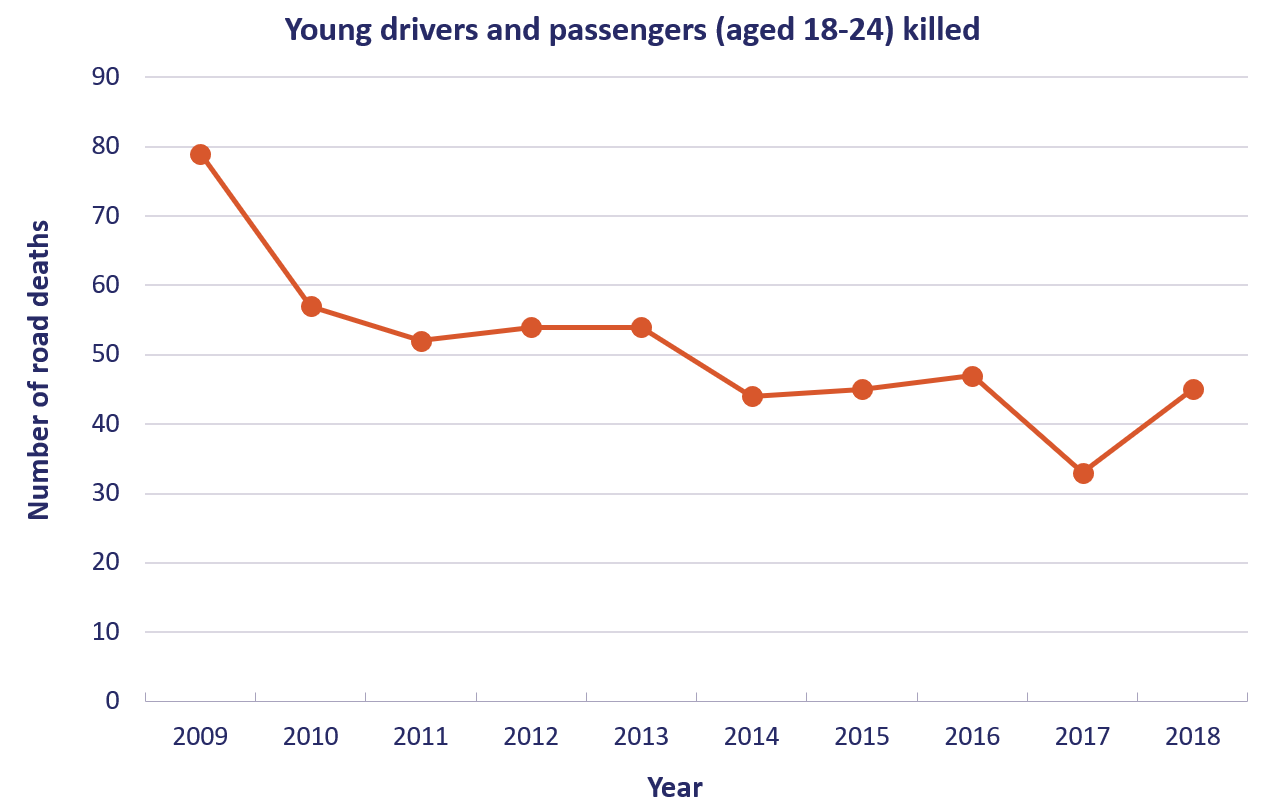 Figure 1. The number of road deaths among young drivers and passengers (aged 18-24) in 2009-2018 (Source: Statistics Netherlands).
Figure 1. The number of road deaths among young drivers and passengers (aged 18-24) in 2009-2018 (Source: Statistics Netherlands). Figure 2. Fatalities among crash opponents by mode of transport, in crashes involving young drivers (aged 18-24) or drivers aged 30 to 65 (BRON, 2015-2019).
Figure 2. Fatalities among crash opponents by mode of transport, in crashes involving young drivers (aged 18-24) or drivers aged 30 to 65 (BRON, 2015-2019).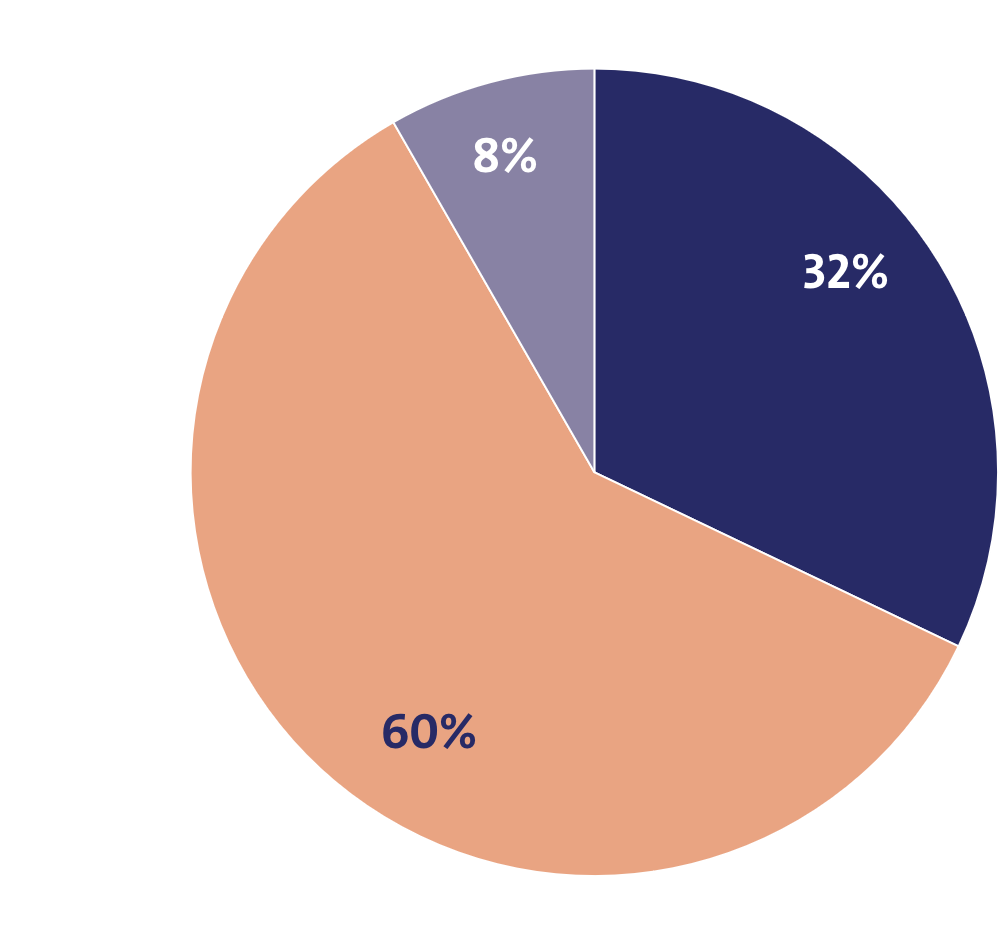
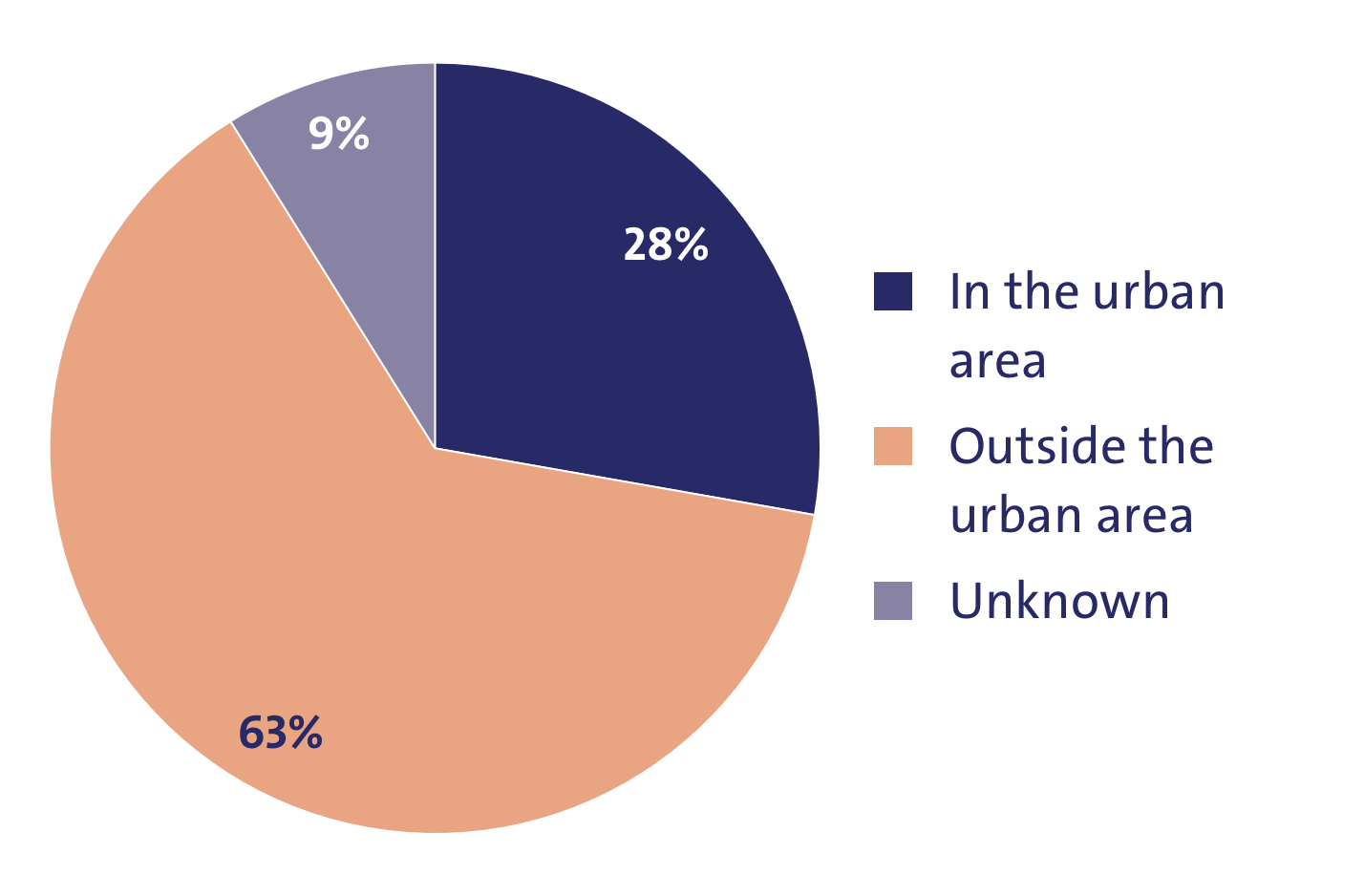
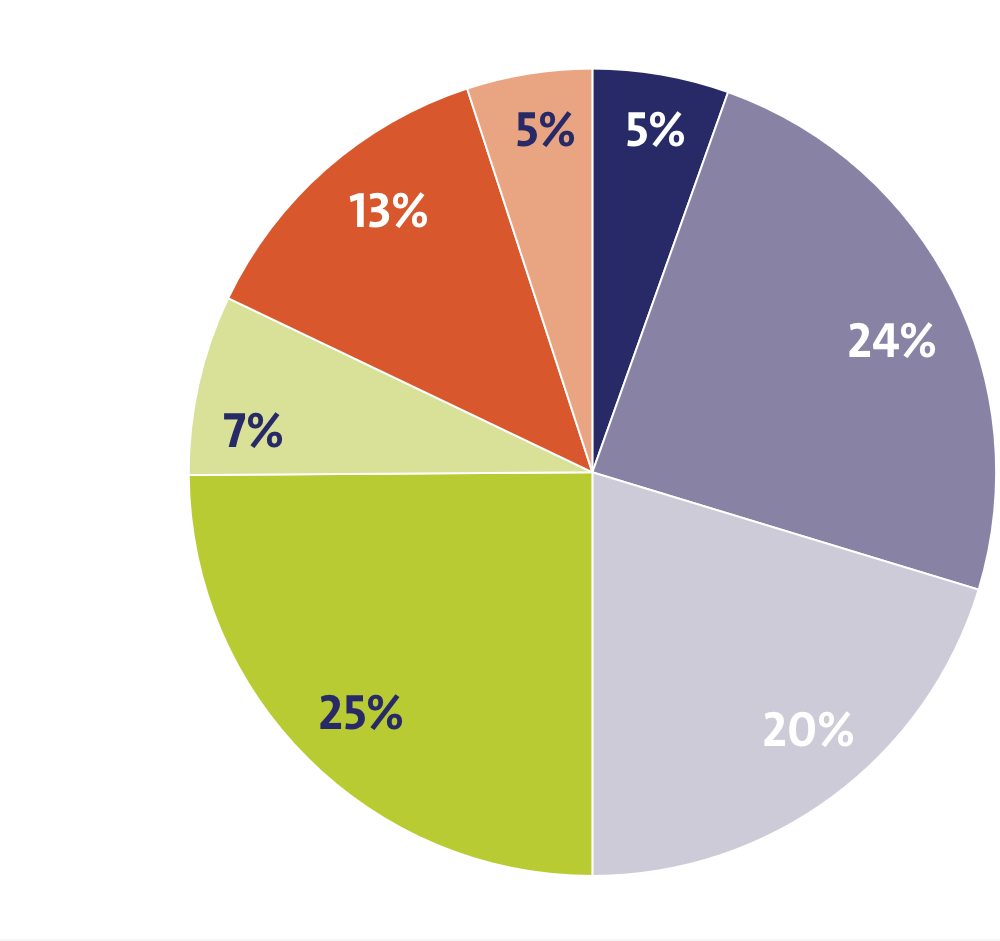
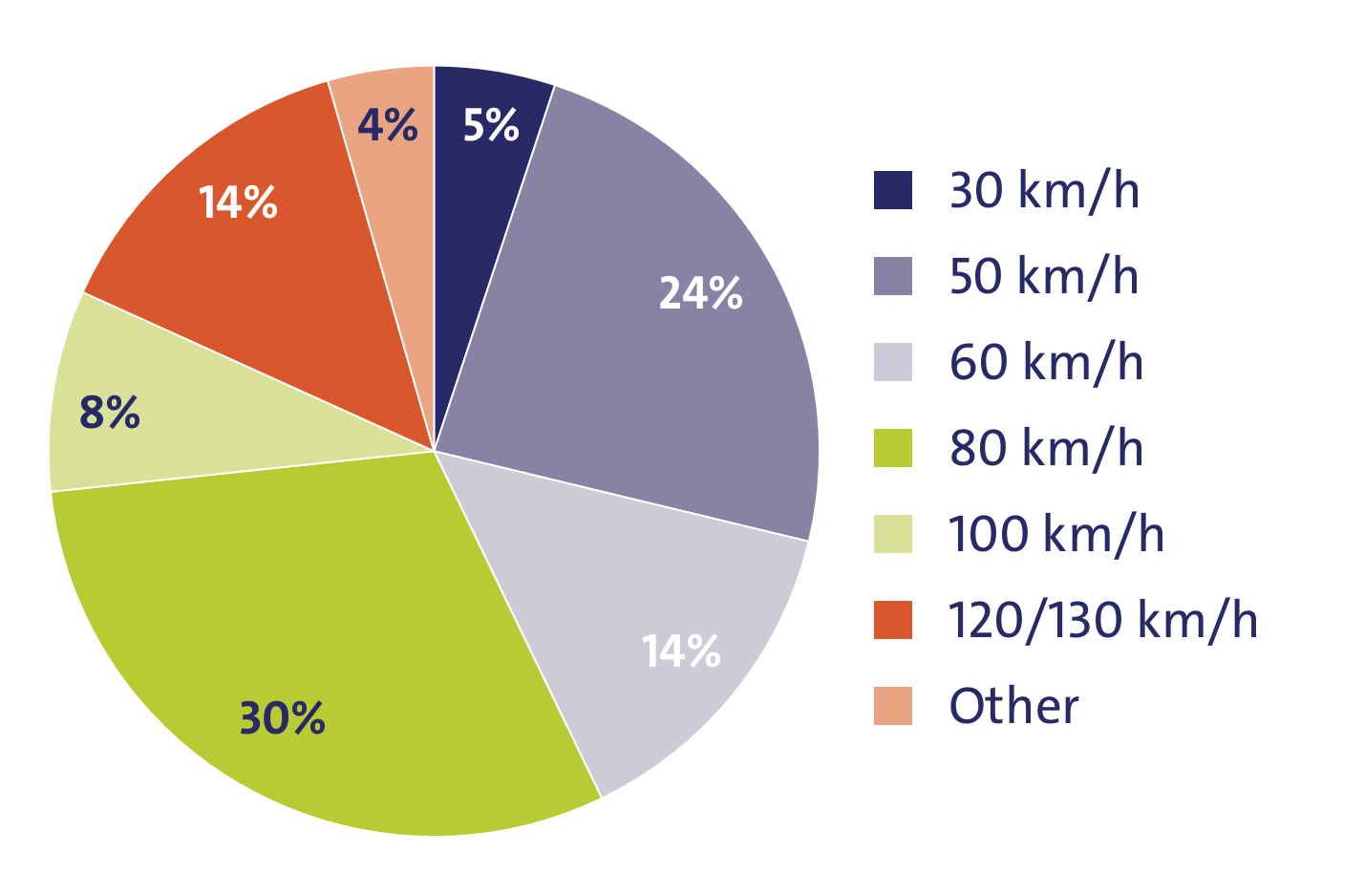
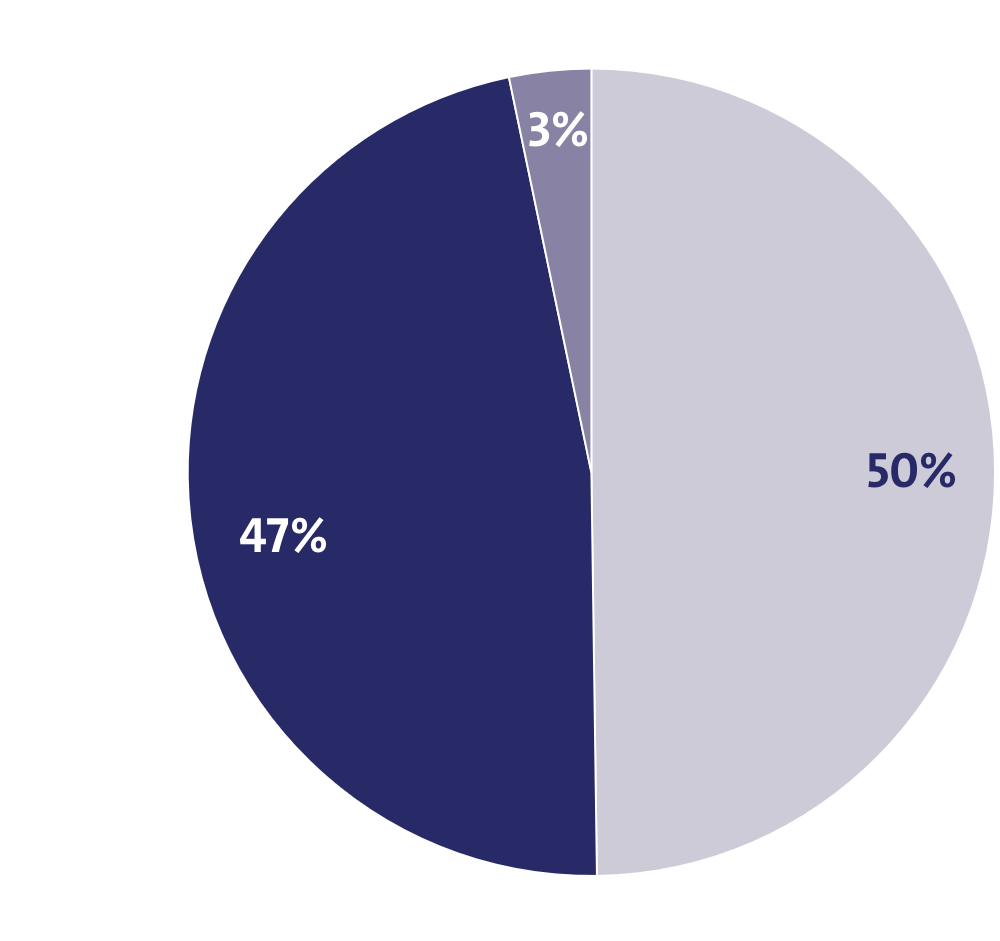
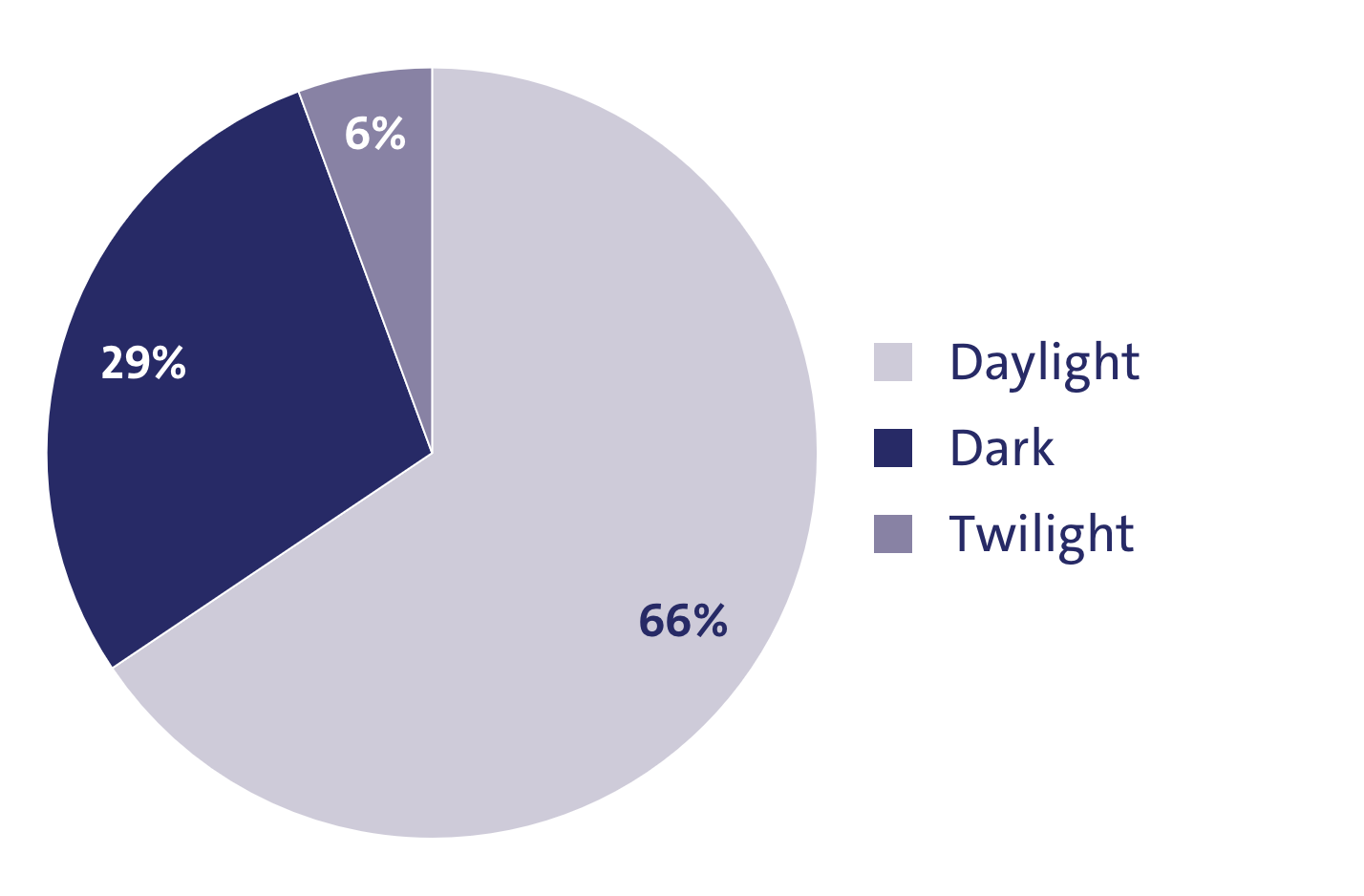
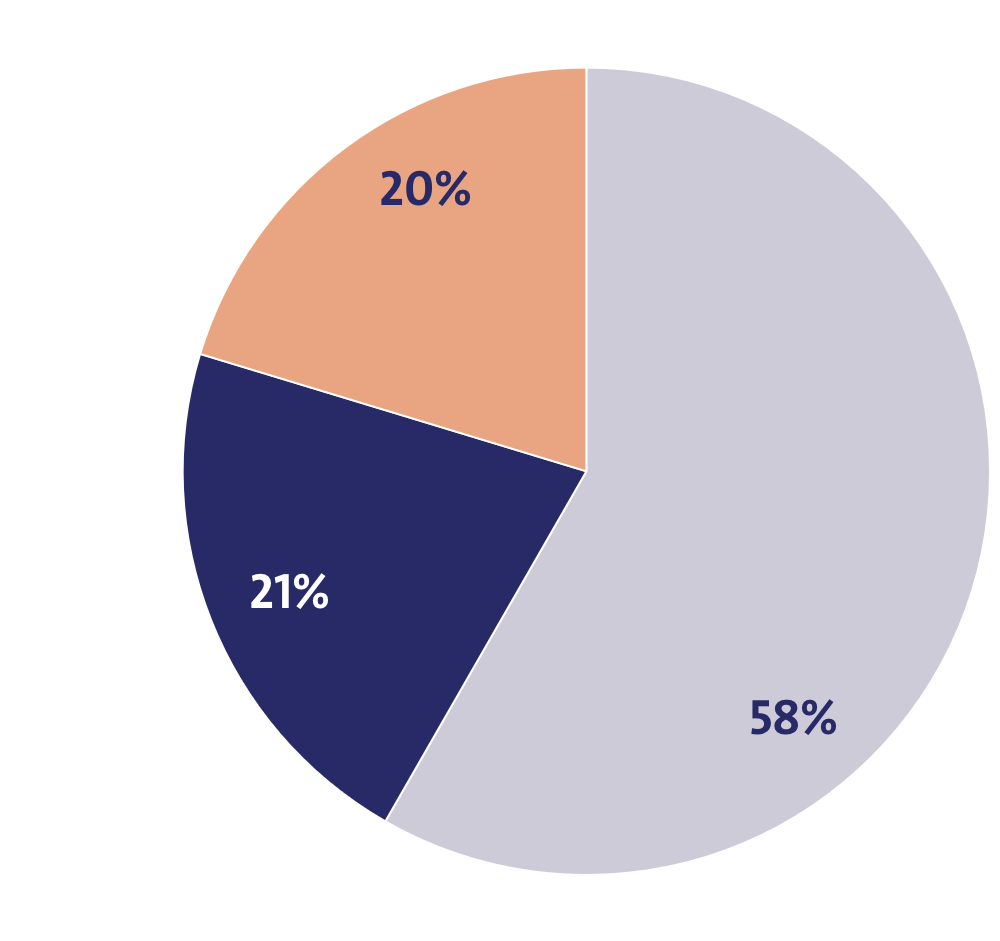
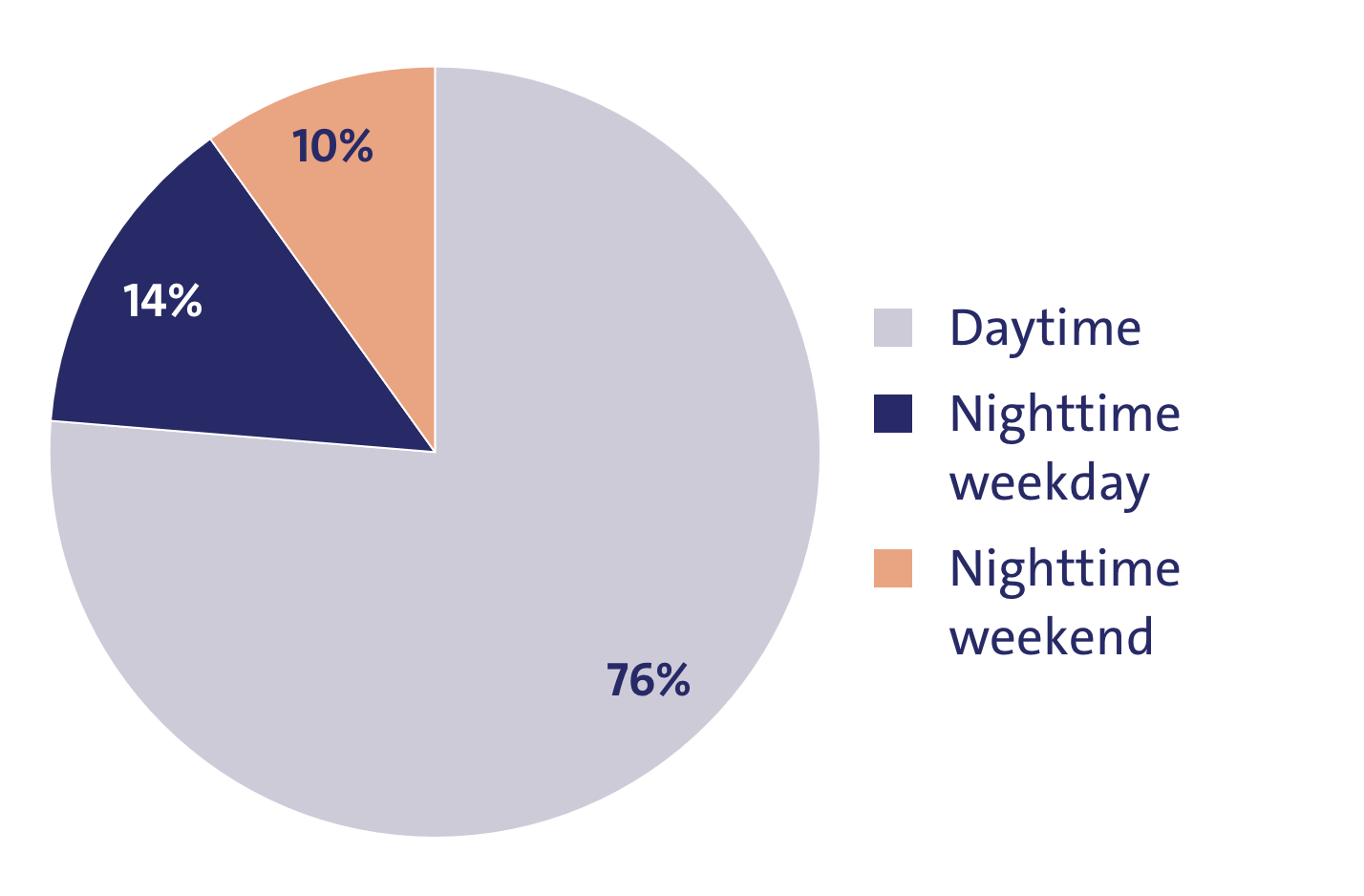

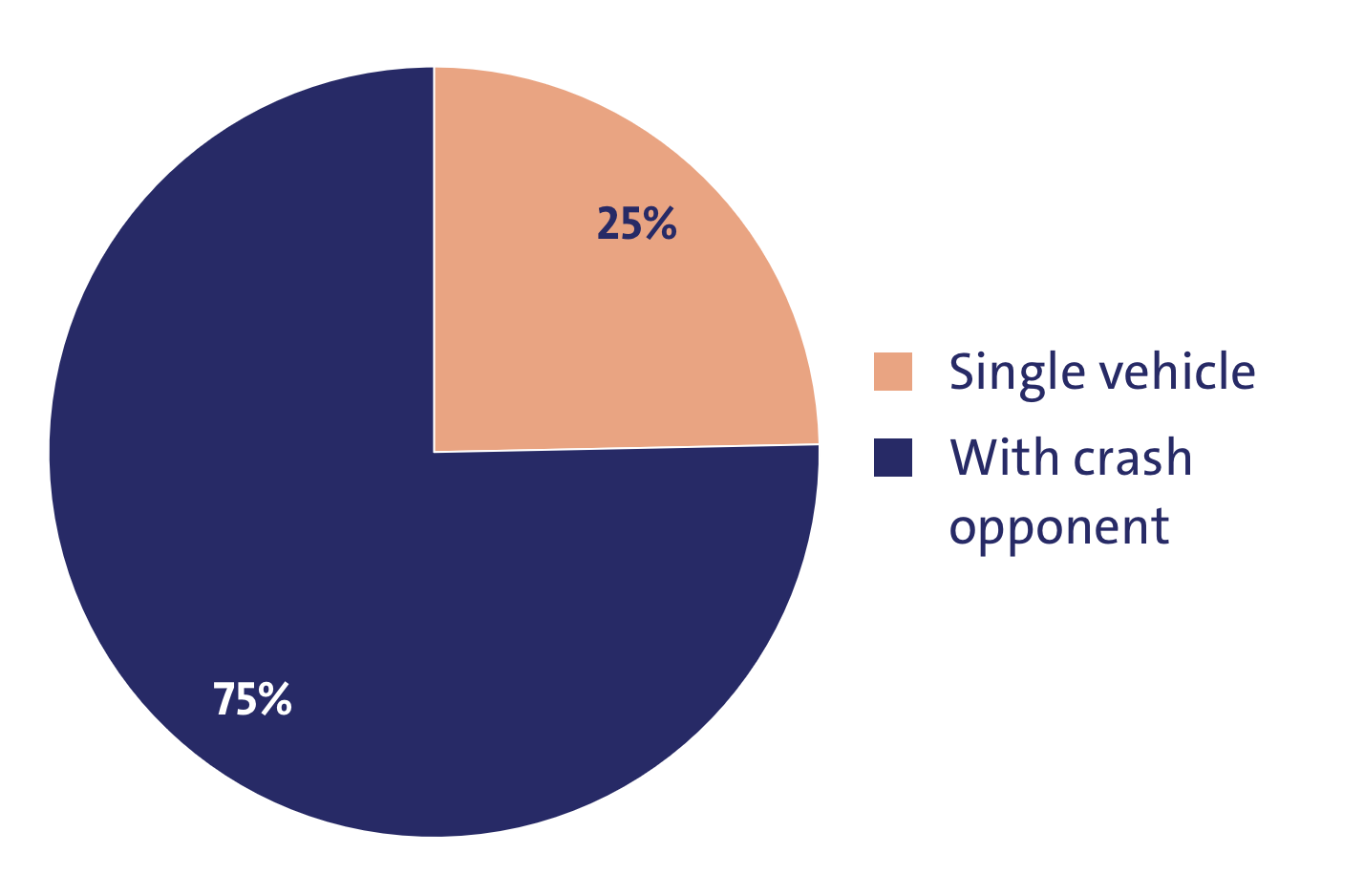
 Figure 3. Decrease of crash risk for novice drivers who started their driving careers early and for novice drivers who started their driving career later/late (based on self-reported crashes and mileage;
Figure 3. Decrease of crash risk for novice drivers who started their driving careers early and for novice drivers who started their driving career later/late (based on self-reported crashes and mileage; 